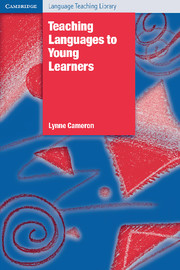Book contents
- Frontmatter
- Contents
- Preface
- Acknowledgements
- 1 Children learning a foreign language
- 2 Learning language through tasks and activities
- 3 Learning the spoken language
- 4 Learning words
- 5 Learning grammar
- 6 Learning literacy skills
- 7 Learning through stories
- 8 Theme-based teaching and learning
- 9 Language choice and language learning
- 10 Assessment and language learning
- 11 Issues around teaching children a foreign language
- References
- Index
6 - Learning literacy skills
Published online by Cambridge University Press: 05 May 2010
- Frontmatter
- Contents
- Preface
- Acknowledgements
- 1 Children learning a foreign language
- 2 Learning language through tasks and activities
- 3 Learning the spoken language
- 4 Learning words
- 5 Learning grammar
- 6 Learning literacy skills
- 7 Learning through stories
- 8 Theme-based teaching and learning
- 9 Language choice and language learning
- 10 Assessment and language learning
- 11 Issues around teaching children a foreign language
- References
- Index
Summary
Introduction
As with previous areas in the young learner classroom, literacy learning needs informed and skilled teaching, and this chapter aims to provide background information to issues in early literacy, and to suggest principles and strategies for classroom teaching based on our current understandings of how children learn to read and write. The reader should be warned in advance that second language literacy is a complicated area and, as far as young learners are concerned, there is much that remains unknown. In the absence of relevant research findings, we will often need to rely on clear thinking and carefully monitored practice as guides in the classroom.
It is important to begin with, and to keep returning to, the idea of reading and writing as language use for expressing and sharing meanings between people. Literacy in this sense is both social and cognitive. Socially, literacy provides people with opportunities to share meanings across space and time. Cognitively, literacy requires that individuals use specific skills and knowledge about how the written language operates in processing text.
The chapter is written in the midst of heated discussion and changes over the teaching of reading and writing in British schools, and also in a time of changing conceptions of reading processes in foreign language teaching. The two sets of changes are not unconnected, and both reflect a realisation that the cognitive and language processes of literacy operate with knowledge and skills at many different levels, and that every level matters. Amongst other things, readers and writers need to recognise individual letters, know how syllables make up words, use information from the whole text and the context.
- Type
- Chapter
- Information
- Teaching Languages to Young Learners , pp. 123 - 158Publisher: Cambridge University PressPrint publication year: 2001

